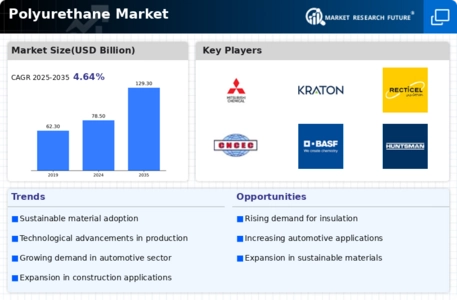Top Industry Leaders in the Polyurethane Market

Polyurethane Market
The PU market is a dynamic ecosystem teeming with competition, innovation, and evolving trends. Staying ahead of the curve will require strategic agility, a focus on sustainability, and continuous R&D efforts. As companies navigate the uncertainties of the global economy and regulatory landscape, those who adapt and embrace novel solutions stand to conquer the ever-expanding frontiers of the PU market.
Strategies for Success in the Polyurethane Market:
-
Product Differentiation: Leading players like BASF, Covestro, and Dow Chemical are diversifying their offerings, specializing in high-performance PU foams for automotive interiors and lightweight composites for aerospace applications. Regional players like Huntsman and Yantai Wanhua are focusing on cost-effective solutions for construction and furniture. -
Sustainability Initiatives: Sustainability concerns are driving investments in bio-based PU and recyclable materials. Companies like Covestro and Evonik are developing PU foams made from castor oil and plant-based polyols. -
Vertical Integration: Integrating backwards to control raw materials and forwards to reach end-users is gaining traction. Dow Chemical's acquisition of Olin's chlor-alkali business and Huntsman's expansion in PU systems integration are prime examples. -
Geographical Expansion: Emerging markets like China, India, and Southeast Asia are witnessing rapid growth. Companies are establishing production facilities and partnerships in these regions to capitalize on the rising demand. -
Digitalization: Leveraging AI and data analytics for production optimization, supply chain management, and customer relationship management is becoming increasingly important.
Factors Influencing Market Share:
-
Product Type: Rigid foams account for the largest share, followed by flexible foams, coatings, and adhesives. Rising demand for lightweight materials in automotive and construction is driving the rigid foam segment. -
Application: The construction industry is the largest end-user, followed by automotive, furniture, and footwear. The growth of these industries directly impacts market share. -
Regional Dynamics: Asia Pacific is the fastest-growing region due to its large and growing population and rapid urbanization. Europe and North America remain mature markets but still offer opportunities in niche segments. -
Environmental Regulations: Stringent regulations on volatile organic compounds (VOCs) and waste management are pushing for the development of eco-friendly PU solutions.
Some of the prominent market leaders in the polyurethane market covered include:
- Covestro AG
- BASF SE
- Huntsman International LLC
- Dow Inc.
- Mitsui & Co. Plastics Ltd
- Tosoh Corporation
- RTP Company
- Mitsubishi Chemical Corporation
- Eastman Chemical Company
- DIC Corporation
- The Lubrizol Corporation
- Woodbridge
- Recticel NV/SA
- RAMPF Holding GmbH & Co. KG
Recent News
RODIM®, a brand of BASF for paint-related products, has quietly released their new TPU Paint Protection Film (PPF), an invisible thermoplastic Polyurethane (TPU) film that provides multifaceted long-lasting protection for automotive coatings across Asia Pacific during August 2022. This RODIM TPU PPF offers additional protection against environmental factors such as high temperatures or long-term exposure to ultraviolet rays during accelerated UV testing for 3,000 hours – by tree sap, bugs, bird droppings, and acid rain that leave stains on the surface of vehicles can be effectively protected by it from tree sap bugs bird droppings acid rain, etc. Additionally, light scratches and scuffs on the film are easily self-healed because they contain TPU.
The production innovation was developed by KEEN in collaboration with Huntsman - Footwear experts – these were sneakers made from plant-based soles known as Field to Foot (F2F). KEEN’s Advanced Concepts Team created these sneakers using Huntsman’s specially formulated bio-based polyurethane system, which includes a residual product from agricultural processing. With bio content ranging between 35% and 51%, the polyurethane system has a lower carbon footprint than the commercial alternatives that are derived from petroleum and are in widespread use today in footwear production. The KEEN specification is a bespoke soling solution based on Huntsman’s DALTOPED® S polyurethane technology platform, developed at Huntsman’s footwear center in Belgium.










